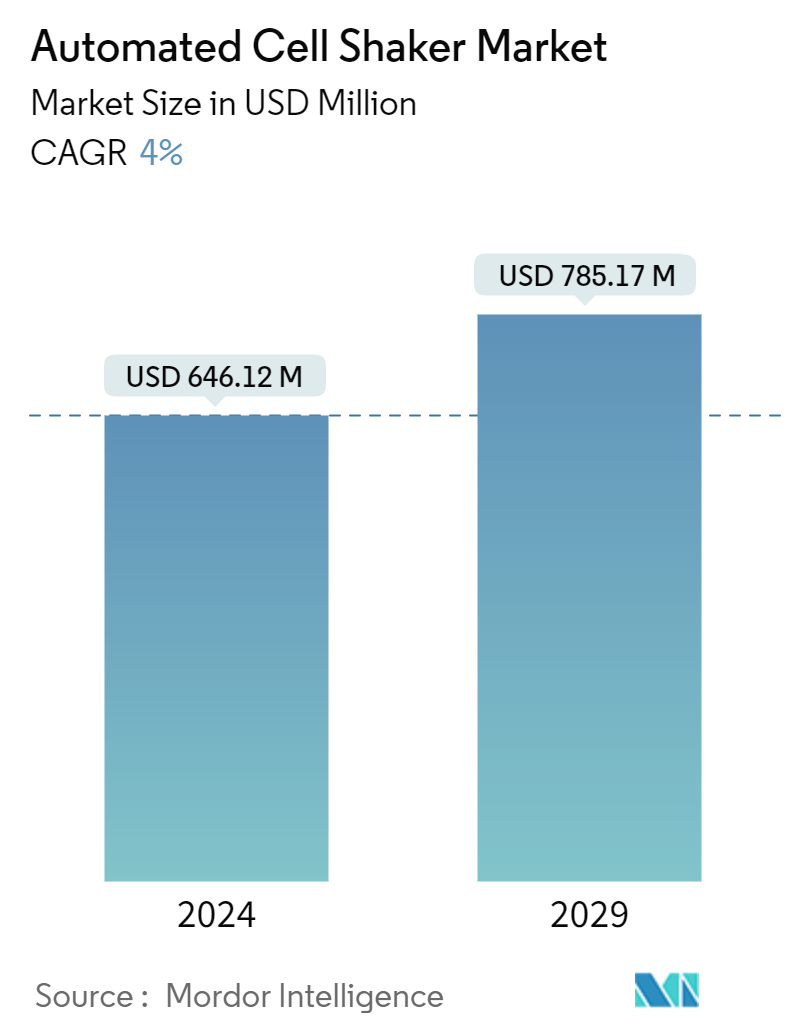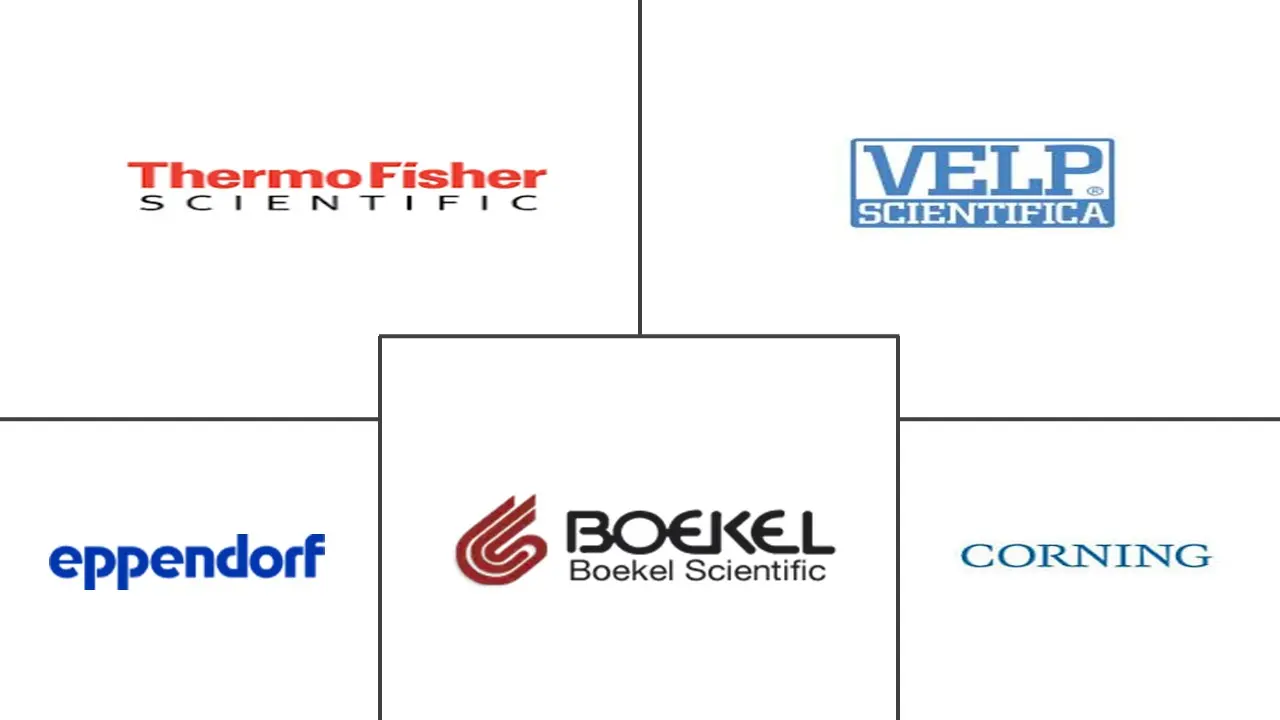Market Size of Automated Cell Shaker Industry

| Study Period | 2019 - 2029 |
| Market Size (2024) | USD 646.12 Million |
| Market Size (2029) | USD 785.17 Million |
| CAGR (2024 - 2029) | 4.00 % |
| Fastest Growing Market | Asia Pacific |
| Largest Market | North America |
Major Players
*Disclaimer: Major Players sorted in no particular order |
Market Overview
The Automated Cell Shaker Market size is estimated at USD 646.12 million in 2024, and is expected to reach USD 785.17 million by 2029, growing at a CAGR of 4% during the forecast period (2024-2029).
The growing demand for cell culture, increasing research and development activities, and growing adoption of high-throughput screening are expected to boost the growth of the automated cell shaker market. Fields like life science, pharmaceuticals, and biotechnology rely heavily on cell culture for drug discovery, vaccine development, and understanding diseases. For instance, in March 2023, data published by the National Institute of Health (NIH) stated that the United States invested heavily in biotechnology research and development (R&D). The country invested USD 8,604 million and USD 8,690 million in 2022 and 2023, respectively.
Personalized medicine focuses on advanced treatments for specific patients based on their unique genetic and molecular profiles. This requires extensive research on individual cell cultures, leading to a higher demand for accurate and efficient manipulation techniques. Automated cell shakers offer consistent and precise shaking conditions, ensuring reliable data and reducing human error, making them ideal for personalized medicine research. Additionally, newer models of shakers offer features like temperature control, CO2 control, and programmable shaking profiles, catering to diverse research needs. Modern cell shakers can be connected to laboratory information management systems (LIMS) for data analysis and integration with other instruments. These shakers enable researchers to perform high-throughput screening and high-content screening (HTS/HCS) assays more efficiently. HTS/HCS assays often involve multiple incubation steps with different shaking conditions. Also, these assays are being increasingly integrated into drug discovery pipelines and basic research studies.
Thus, growing demand for cell culture, increasing research and development activities, and demand for personalized medicine are expected to drive the growth of the automated cell shaker market.
However, a lack of standardization in underdeveloped countries can limit the growth of the market.
Scope of the Report
An automated cell shaker is a laboratory instrument used to stir/rotate cell cultures in a controlled and consistent manner.
The automated cell shaker market is segmented by product, cell culture type, application, end user, and geography. By product, the market is segmented into automated cell shakers, orbital shakers, ambient shakers, benchtop incubator shakers, cell shakers with rotatory arms, and accessories. By cell culture type, the market is segmented into infinite cell line cultures and finite cell line cultures. By application, the market is segmented into drug development, regenerative medicine, cell therapy, and stem cell research. By end user, the market is segmented into pharmaceutical companies, biopharmaceutical companies, CDMOs/CMOs, hospitals, and other end users. By geography, the market is segmented into North America, Europe, Asia-Pacific, Middle East and Africa, and South America. The report also covers the estimated market sizes and trends for 17 countries across major regions globally. The report offers market sizes and forecasts in terms of value (USD) for all the above segments.
| By Product | |
| Automated Cell Shakers | |
| Orbital Shakers | |
| Ambient Shakers | |
| Benchtop Incubator Shakers | |
| Cell Shaker with Rotatory Arms | |
| Accessories |
| By Cell Culture Type | |
| Infinite Cell Line Cultures | |
| Finite Cell Line Cultures |
| By Application | |
| Drug Development | |
| Regenerative Medicine | |
| Cell Therapy | |
| Stem Cell Research |
| By End User | |
| Pharmaceutical Companies | |
| Biopharmaceutical Companies, | |
| CDMOs/CMOs | |
| Hospitals | |
| Other End Users |
| Geography | ||||||||
| ||||||||
| ||||||||
| ||||||||
| ||||||||
|
Automated Cell Shaker Market Size Summary
The automated cell shaker market is poised for growth, driven by the increasing demand for cell culture and the expansion of research and development activities across various sectors such as life sciences, pharmaceuticals, and biotechnology. These industries heavily rely on cell culture for critical processes like drug discovery, vaccine development, and disease understanding. The rise of personalized medicine, which necessitates extensive research on individual cell cultures, further fuels the demand for automated cell shakers. These devices offer consistent and precise shaking conditions, reducing human error and ensuring reliable data. Modern shakers are equipped with advanced features like temperature and CO2 control, programmable shaking profiles, and integration with laboratory information management systems, enhancing their utility in high-throughput and high-content screening assays. Despite the promising growth prospects, the market faces challenges in underdeveloped regions due to a lack of standardization.
The orbital shakers segment is expected to experience significant growth, supported by the high demand for modern orbital shakers in biopharmaceutical research, drug discovery, stem cell research, and personalized medicine. Manufacturers are focusing on product innovations and expanding their distribution networks to reach broader markets. North America is anticipated to dominate the market, bolstered by its robust R&D ecosystem and substantial investments in biotechnology, pharmaceuticals, and life sciences. The region's advanced pharmaceutical and biotechnology industries, along with government and private sector investments in research infrastructure, contribute to its leading position. The competitive landscape of the automated cell shaker market is moderately consolidated, with key players like Thermo Fisher Scientific Inc., Eppendorf SE, and Corning Incorporated focusing on regulatory approvals and product launches to enhance their global presence.
Automated Cell Shaker Market Size - Table of Contents
-
1. MARKET DYNAMICS
-
1.1 Market Overview
-
1.2 Market Drivers
-
1.2.1 The Growing Demand for Cell Culture
-
1.2.2 Rising Research in Fields like Life Sciences and Biotechnology
-
-
1.3 Market Restraints
-
1.3.1 Lack of Standardization in Underdeveloped Countries
-
-
1.4 Porter's Five Forces Analysis
-
1.4.1 Threat of New Entrants
-
1.4.2 Bargaining Power of Buyers/Consumers
-
1.4.3 Bargaining Power of Suppliers
-
1.4.4 Threat of Substitute Products
-
1.4.5 Intensity of Competitive Rivalry
-
-
-
2. MARKET SEGMENTATION (Market Size by Value - USD)
-
2.1 By Product
-
2.1.1 Automated Cell Shakers
-
2.1.2 Orbital Shakers
-
2.1.3 Ambient Shakers
-
2.1.4 Benchtop Incubator Shakers
-
2.1.5 Cell Shaker with Rotatory Arms
-
2.1.6 Accessories
-
-
2.2 By Cell Culture Type
-
2.2.1 Infinite Cell Line Cultures
-
2.2.2 Finite Cell Line Cultures
-
-
2.3 By Application
-
2.3.1 Drug Development
-
2.3.2 Regenerative Medicine
-
2.3.3 Cell Therapy
-
2.3.4 Stem Cell Research
-
-
2.4 By End User
-
2.4.1 Pharmaceutical Companies
-
2.4.2 Biopharmaceutical Companies,
-
2.4.3 CDMOs/CMOs
-
2.4.4 Hospitals
-
2.4.5 Other End Users
-
-
2.5 Geography
-
2.5.1 North America
-
2.5.1.1 United States
-
2.5.1.2 Canada
-
2.5.1.3 Mexico
-
-
2.5.2 Europe
-
2.5.2.1 Germany
-
2.5.2.2 United Kingdom
-
2.5.2.3 France
-
2.5.2.4 Italy
-
2.5.2.5 Spain
-
2.5.2.6 Rest of Europe
-
-
2.5.3 Asia-Pacific
-
2.5.3.1 China
-
2.5.3.2 Japan
-
2.5.3.3 India
-
2.5.3.4 Australia
-
2.5.3.5 South Korea
-
2.5.3.6 Rest of Asia-Pacific
-
-
2.5.4 Middle East and Africa
-
2.5.4.1 GCC
-
2.5.4.2 South Africa
-
2.5.4.3 Rest of Middle East and Africa
-
-
2.5.5 South America
-
2.5.5.1 Brazil
-
2.5.5.2 Argentina
-
2.5.5.3 Rest of South America
-
-
-
Automated Cell Shaker Market Size FAQs
How big is the Automated Cell Shaker Market?
The Automated Cell Shaker Market size is expected to reach USD 646.12 million in 2024 and grow at a CAGR of 4% to reach USD 785.17 million by 2029.
What is the current Automated Cell Shaker Market size?
In 2024, the Automated Cell Shaker Market size is expected to reach USD 646.12 million.

